Software Testing
VerifiedAdded on 2023/03/31
|18
|3627
|420
AI Summary
This document provides an overview of the system, purpose of the test, test objectives, project scope, important resources, test plan, and description of test cases for software testing.
Contribute Materials
Your contribution can guide someone’s learning journey. Share your
documents today.
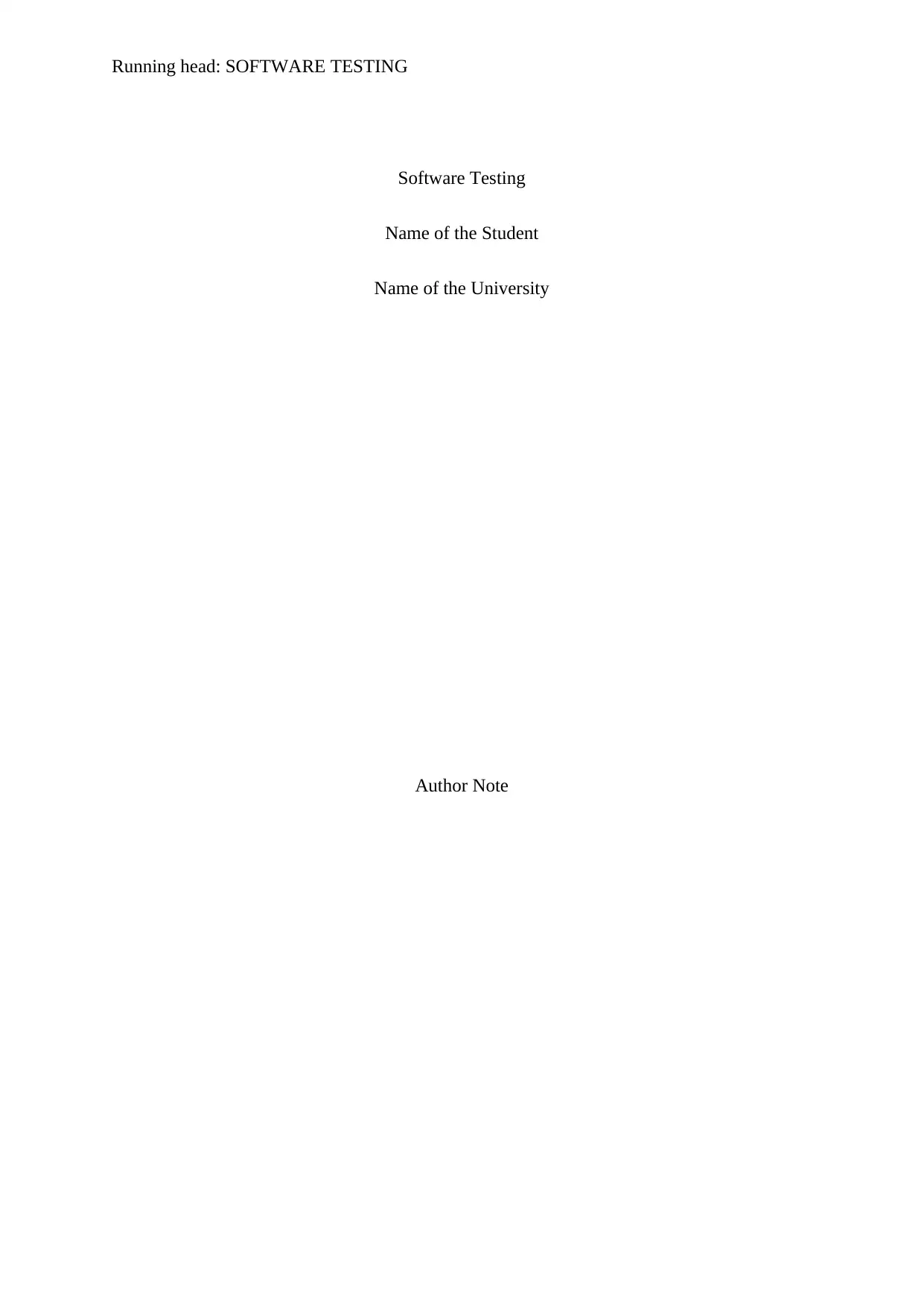
Running head: SOFTWARE TESTING
Software Testing
Name of the Student
Name of the University
Author Note
Software Testing
Name of the Student
Name of the University
Author Note
Secure Best Marks with AI Grader
Need help grading? Try our AI Grader for instant feedback on your assignments.
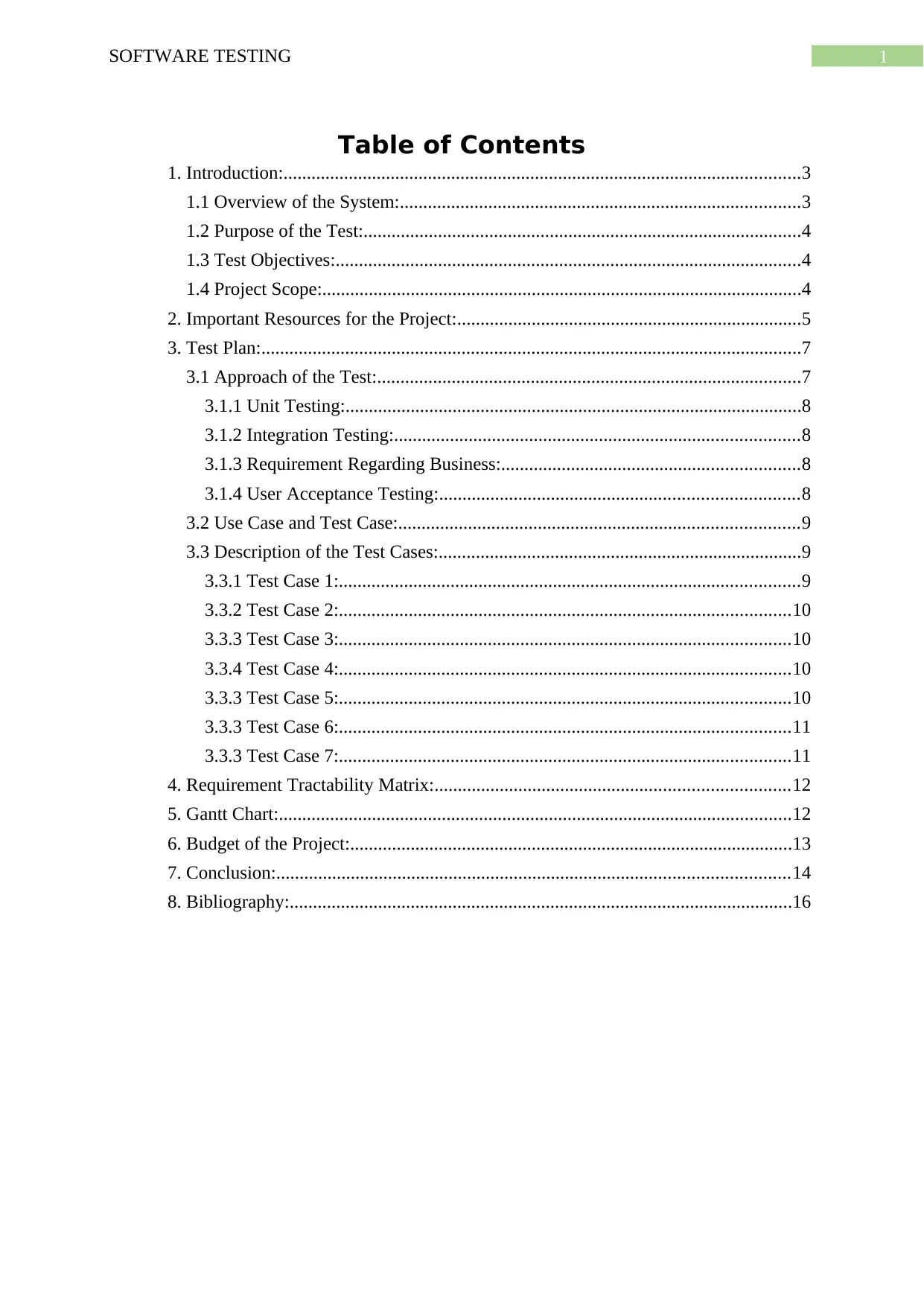
1SOFTWARE TESTING
Table of Contents
1. Introduction:...............................................................................................................3
1.1 Overview of the System:......................................................................................3
1.2 Purpose of the Test:..............................................................................................4
1.3 Test Objectives:....................................................................................................4
1.4 Project Scope:.......................................................................................................4
2. Important Resources for the Project:..........................................................................5
3. Test Plan:....................................................................................................................7
3.1 Approach of the Test:...........................................................................................7
3.1.1 Unit Testing:..................................................................................................8
3.1.2 Integration Testing:.......................................................................................8
3.1.3 Requirement Regarding Business:................................................................8
3.1.4 User Acceptance Testing:.............................................................................8
3.2 Use Case and Test Case:......................................................................................9
3.3 Description of the Test Cases:..............................................................................9
3.3.1 Test Case 1:...................................................................................................9
3.3.2 Test Case 2:.................................................................................................10
3.3.3 Test Case 3:.................................................................................................10
3.3.4 Test Case 4:.................................................................................................10
3.3.3 Test Case 5:.................................................................................................10
3.3.3 Test Case 6:.................................................................................................11
3.3.3 Test Case 7:.................................................................................................11
4. Requirement Tractability Matrix:............................................................................12
5. Gantt Chart:..............................................................................................................12
6. Budget of the Project:...............................................................................................13
7. Conclusion:..............................................................................................................14
8. Bibliography:............................................................................................................16
Table of Contents
1. Introduction:...............................................................................................................3
1.1 Overview of the System:......................................................................................3
1.2 Purpose of the Test:..............................................................................................4
1.3 Test Objectives:....................................................................................................4
1.4 Project Scope:.......................................................................................................4
2. Important Resources for the Project:..........................................................................5
3. Test Plan:....................................................................................................................7
3.1 Approach of the Test:...........................................................................................7
3.1.1 Unit Testing:..................................................................................................8
3.1.2 Integration Testing:.......................................................................................8
3.1.3 Requirement Regarding Business:................................................................8
3.1.4 User Acceptance Testing:.............................................................................8
3.2 Use Case and Test Case:......................................................................................9
3.3 Description of the Test Cases:..............................................................................9
3.3.1 Test Case 1:...................................................................................................9
3.3.2 Test Case 2:.................................................................................................10
3.3.3 Test Case 3:.................................................................................................10
3.3.4 Test Case 4:.................................................................................................10
3.3.3 Test Case 5:.................................................................................................10
3.3.3 Test Case 6:.................................................................................................11
3.3.3 Test Case 7:.................................................................................................11
4. Requirement Tractability Matrix:............................................................................12
5. Gantt Chart:..............................................................................................................12
6. Budget of the Project:...............................................................................................13
7. Conclusion:..............................................................................................................14
8. Bibliography:............................................................................................................16

2SOFTWARE TESTING
1. Introduction:
A software testing plan is very much important for determining whether a developed
software is perfectly functioning or not. This is the main reason for the development of
software testing plan. In this context a software testing plan will be developed for the system
of online backstage management. For a perfect software testing plan it is very much
important to utilise different types of strategies. This properties of a proper software testing
plan has been followed while the testing plan is in being developed.
1.1 Overview of the System:
For the management of the online backstage system eStage application has been
developed in this context. This application has been designed in such a way, that it will be
select the roles of each of the stakeholders who are currently related with the online
backstage management system. This system is secured with some protection and the system
users needs to login in this system by specifying their current roles in the system and with
that they also need to pass the mechanism of the authentication for using all the features of
the system that is offered by the current system. By following this steps a particular user will
be able to login to the current system and after they have logged in successfully, the users
will be directly redirected to the welcome page or the index page of the system which
consists several of other links which are provided to different types of users accordingly. In
this context there are various of options which can be selected by the user. Including the
factors such as home, logoff, sections, discipline and competitors. All of the available
information can be the users by selection of appropriate type of options and by also choosing
the system more wisely. Within this information system, registration can be done by the
competitors by processing their information for various of services and after that important
information will be provided to them which consisting different types of roles. In this context
1. Introduction:
A software testing plan is very much important for determining whether a developed
software is perfectly functioning or not. This is the main reason for the development of
software testing plan. In this context a software testing plan will be developed for the system
of online backstage management. For a perfect software testing plan it is very much
important to utilise different types of strategies. This properties of a proper software testing
plan has been followed while the testing plan is in being developed.
1.1 Overview of the System:
For the management of the online backstage system eStage application has been
developed in this context. This application has been designed in such a way, that it will be
select the roles of each of the stakeholders who are currently related with the online
backstage management system. This system is secured with some protection and the system
users needs to login in this system by specifying their current roles in the system and with
that they also need to pass the mechanism of the authentication for using all the features of
the system that is offered by the current system. By following this steps a particular user will
be able to login to the current system and after they have logged in successfully, the users
will be directly redirected to the welcome page or the index page of the system which
consists several of other links which are provided to different types of users accordingly. In
this context there are various of options which can be selected by the user. Including the
factors such as home, logoff, sections, discipline and competitors. All of the available
information can be the users by selection of appropriate type of options and by also choosing
the system more wisely. Within this information system, registration can be done by the
competitors by processing their information for various of services and after that important
information will be provided to them which consisting different types of roles. In this context
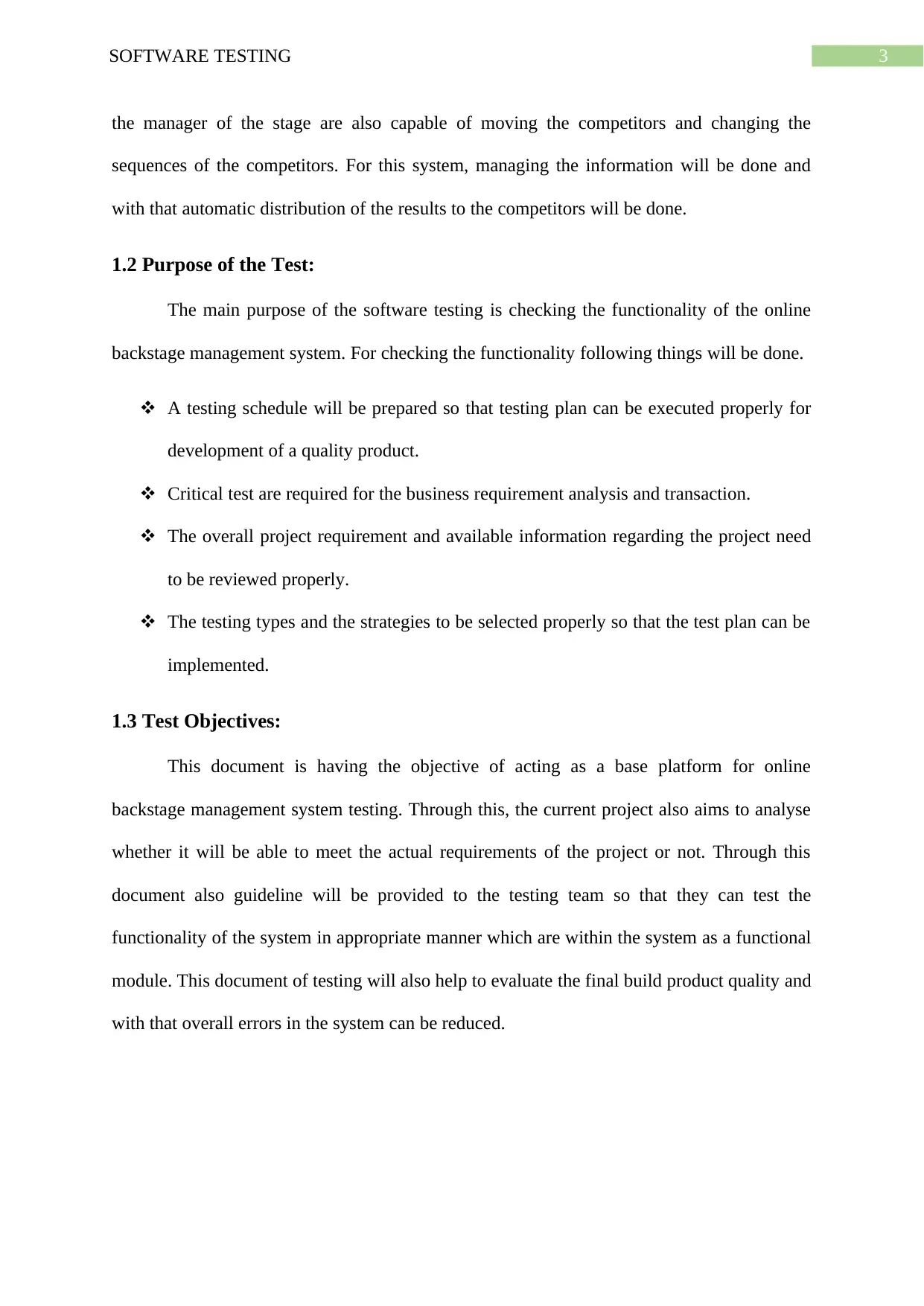
3SOFTWARE TESTING
the manager of the stage are also capable of moving the competitors and changing the
sequences of the competitors. For this system, managing the information will be done and
with that automatic distribution of the results to the competitors will be done.
1.2 Purpose of the Test:
The main purpose of the software testing is checking the functionality of the online
backstage management system. For checking the functionality following things will be done.
A testing schedule will be prepared so that testing plan can be executed properly for
development of a quality product.
Critical test are required for the business requirement analysis and transaction.
The overall project requirement and available information regarding the project need
to be reviewed properly.
The testing types and the strategies to be selected properly so that the test plan can be
implemented.
1.3 Test Objectives:
This document is having the objective of acting as a base platform for online
backstage management system testing. Through this, the current project also aims to analyse
whether it will be able to meet the actual requirements of the project or not. Through this
document also guideline will be provided to the testing team so that they can test the
functionality of the system in appropriate manner which are within the system as a functional
module. This document of testing will also help to evaluate the final build product quality and
with that overall errors in the system can be reduced.
the manager of the stage are also capable of moving the competitors and changing the
sequences of the competitors. For this system, managing the information will be done and
with that automatic distribution of the results to the competitors will be done.
1.2 Purpose of the Test:
The main purpose of the software testing is checking the functionality of the online
backstage management system. For checking the functionality following things will be done.
A testing schedule will be prepared so that testing plan can be executed properly for
development of a quality product.
Critical test are required for the business requirement analysis and transaction.
The overall project requirement and available information regarding the project need
to be reviewed properly.
The testing types and the strategies to be selected properly so that the test plan can be
implemented.
1.3 Test Objectives:
This document is having the objective of acting as a base platform for online
backstage management system testing. Through this, the current project also aims to analyse
whether it will be able to meet the actual requirements of the project or not. Through this
document also guideline will be provided to the testing team so that they can test the
functionality of the system in appropriate manner which are within the system as a functional
module. This document of testing will also help to evaluate the final build product quality and
with that overall errors in the system can be reduced.
Secure Best Marks with AI Grader
Need help grading? Try our AI Grader for instant feedback on your assignments.
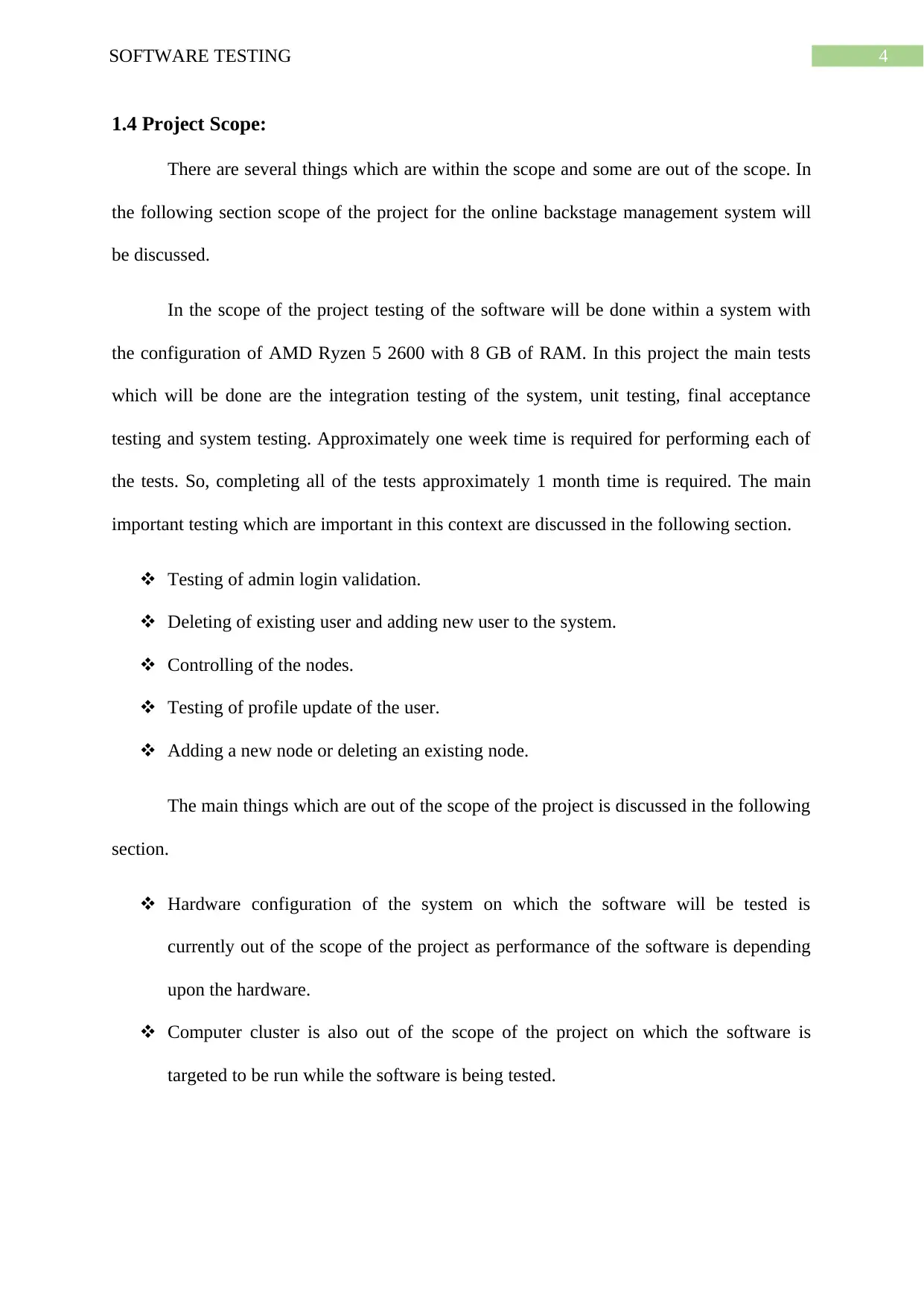
4SOFTWARE TESTING
1.4 Project Scope:
There are several things which are within the scope and some are out of the scope. In
the following section scope of the project for the online backstage management system will
be discussed.
In the scope of the project testing of the software will be done within a system with
the configuration of AMD Ryzen 5 2600 with 8 GB of RAM. In this project the main tests
which will be done are the integration testing of the system, unit testing, final acceptance
testing and system testing. Approximately one week time is required for performing each of
the tests. So, completing all of the tests approximately 1 month time is required. The main
important testing which are important in this context are discussed in the following section.
Testing of admin login validation.
Deleting of existing user and adding new user to the system.
Controlling of the nodes.
Testing of profile update of the user.
Adding a new node or deleting an existing node.
The main things which are out of the scope of the project is discussed in the following
section.
Hardware configuration of the system on which the software will be tested is
currently out of the scope of the project as performance of the software is depending
upon the hardware.
Computer cluster is also out of the scope of the project on which the software is
targeted to be run while the software is being tested.
1.4 Project Scope:
There are several things which are within the scope and some are out of the scope. In
the following section scope of the project for the online backstage management system will
be discussed.
In the scope of the project testing of the software will be done within a system with
the configuration of AMD Ryzen 5 2600 with 8 GB of RAM. In this project the main tests
which will be done are the integration testing of the system, unit testing, final acceptance
testing and system testing. Approximately one week time is required for performing each of
the tests. So, completing all of the tests approximately 1 month time is required. The main
important testing which are important in this context are discussed in the following section.
Testing of admin login validation.
Deleting of existing user and adding new user to the system.
Controlling of the nodes.
Testing of profile update of the user.
Adding a new node or deleting an existing node.
The main things which are out of the scope of the project is discussed in the following
section.
Hardware configuration of the system on which the software will be tested is
currently out of the scope of the project as performance of the software is depending
upon the hardware.
Computer cluster is also out of the scope of the project on which the software is
targeted to be run while the software is being tested.
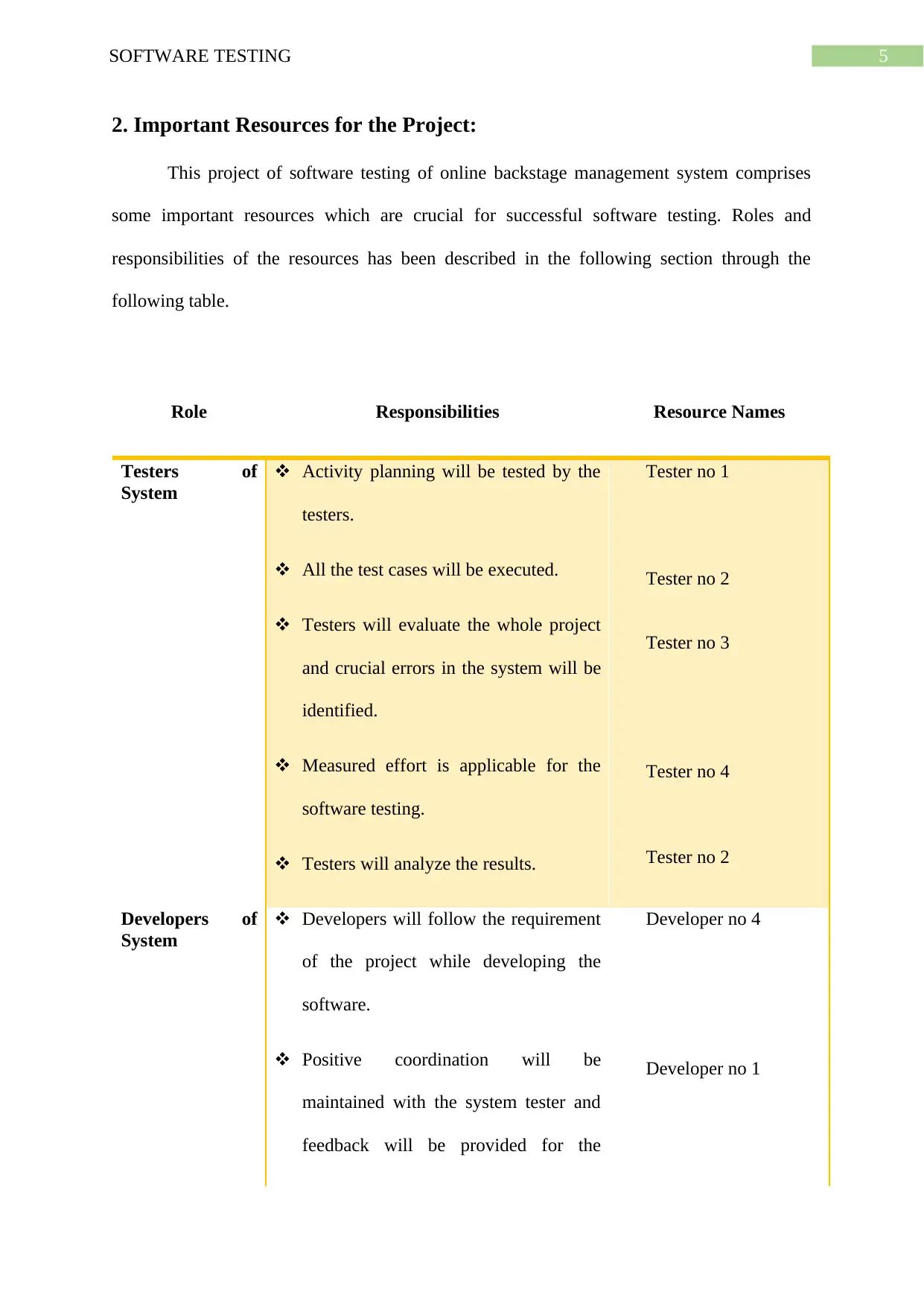
5SOFTWARE TESTING
2. Important Resources for the Project:
This project of software testing of online backstage management system comprises
some important resources which are crucial for successful software testing. Roles and
responsibilities of the resources has been described in the following section through the
following table.
Role Responsibilities Resource Names
Testers of
System
Activity planning will be tested by the
testers.
All the test cases will be executed.
Testers will evaluate the whole project
and crucial errors in the system will be
identified.
Measured effort is applicable for the
software testing.
Testers will analyze the results.
Tester no 1
Tester no 2
Tester no 3
Tester no 4
Tester no 2
Developers of
System
Developers will follow the requirement
of the project while developing the
software.
Positive coordination will be
maintained with the system tester and
feedback will be provided for the
Developer no 4
Developer no 1
2. Important Resources for the Project:
This project of software testing of online backstage management system comprises
some important resources which are crucial for successful software testing. Roles and
responsibilities of the resources has been described in the following section through the
following table.
Role Responsibilities Resource Names
Testers of
System
Activity planning will be tested by the
testers.
All the test cases will be executed.
Testers will evaluate the whole project
and crucial errors in the system will be
identified.
Measured effort is applicable for the
software testing.
Testers will analyze the results.
Tester no 1
Tester no 2
Tester no 3
Tester no 4
Tester no 2
Developers of
System
Developers will follow the requirement
of the project while developing the
software.
Positive coordination will be
maintained with the system tester and
feedback will be provided for the
Developer no 4
Developer no 1
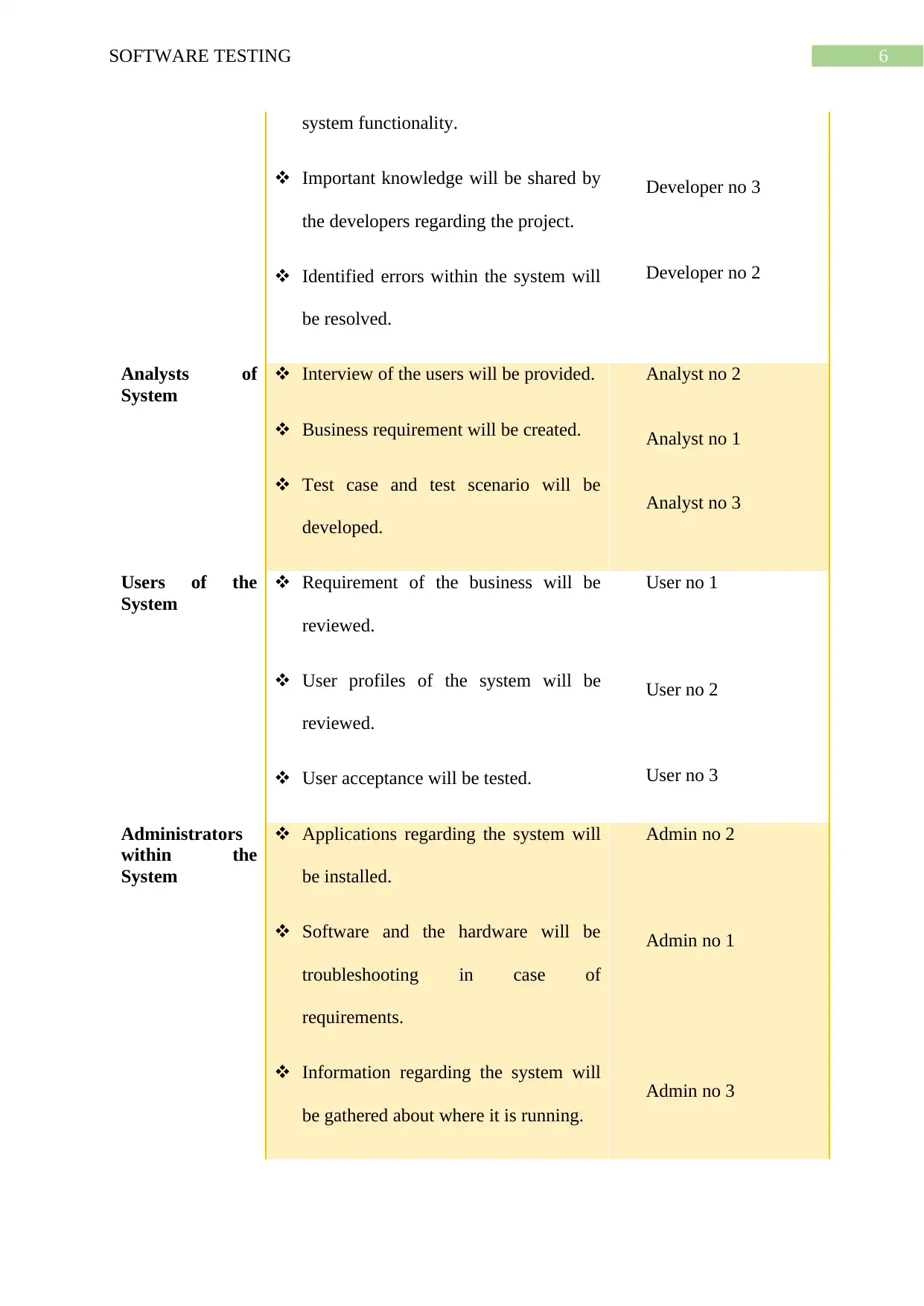
6SOFTWARE TESTING
system functionality.
Important knowledge will be shared by
the developers regarding the project.
Identified errors within the system will
be resolved.
Developer no 3
Developer no 2
Analysts of
System
Interview of the users will be provided.
Business requirement will be created.
Test case and test scenario will be
developed.
Analyst no 2
Analyst no 1
Analyst no 3
Users of the
System
Requirement of the business will be
reviewed.
User profiles of the system will be
reviewed.
User acceptance will be tested.
User no 1
User no 2
User no 3
Administrators
within the
System
Applications regarding the system will
be installed.
Software and the hardware will be
troubleshooting in case of
requirements.
Information regarding the system will
be gathered about where it is running.
Admin no 2
Admin no 1
Admin no 3
system functionality.
Important knowledge will be shared by
the developers regarding the project.
Identified errors within the system will
be resolved.
Developer no 3
Developer no 2
Analysts of
System
Interview of the users will be provided.
Business requirement will be created.
Test case and test scenario will be
developed.
Analyst no 2
Analyst no 1
Analyst no 3
Users of the
System
Requirement of the business will be
reviewed.
User profiles of the system will be
reviewed.
User acceptance will be tested.
User no 1
User no 2
User no 3
Administrators
within the
System
Applications regarding the system will
be installed.
Software and the hardware will be
troubleshooting in case of
requirements.
Information regarding the system will
be gathered about where it is running.
Admin no 2
Admin no 1
Admin no 3
Paraphrase This Document
Need a fresh take? Get an instant paraphrase of this document with our AI Paraphraser
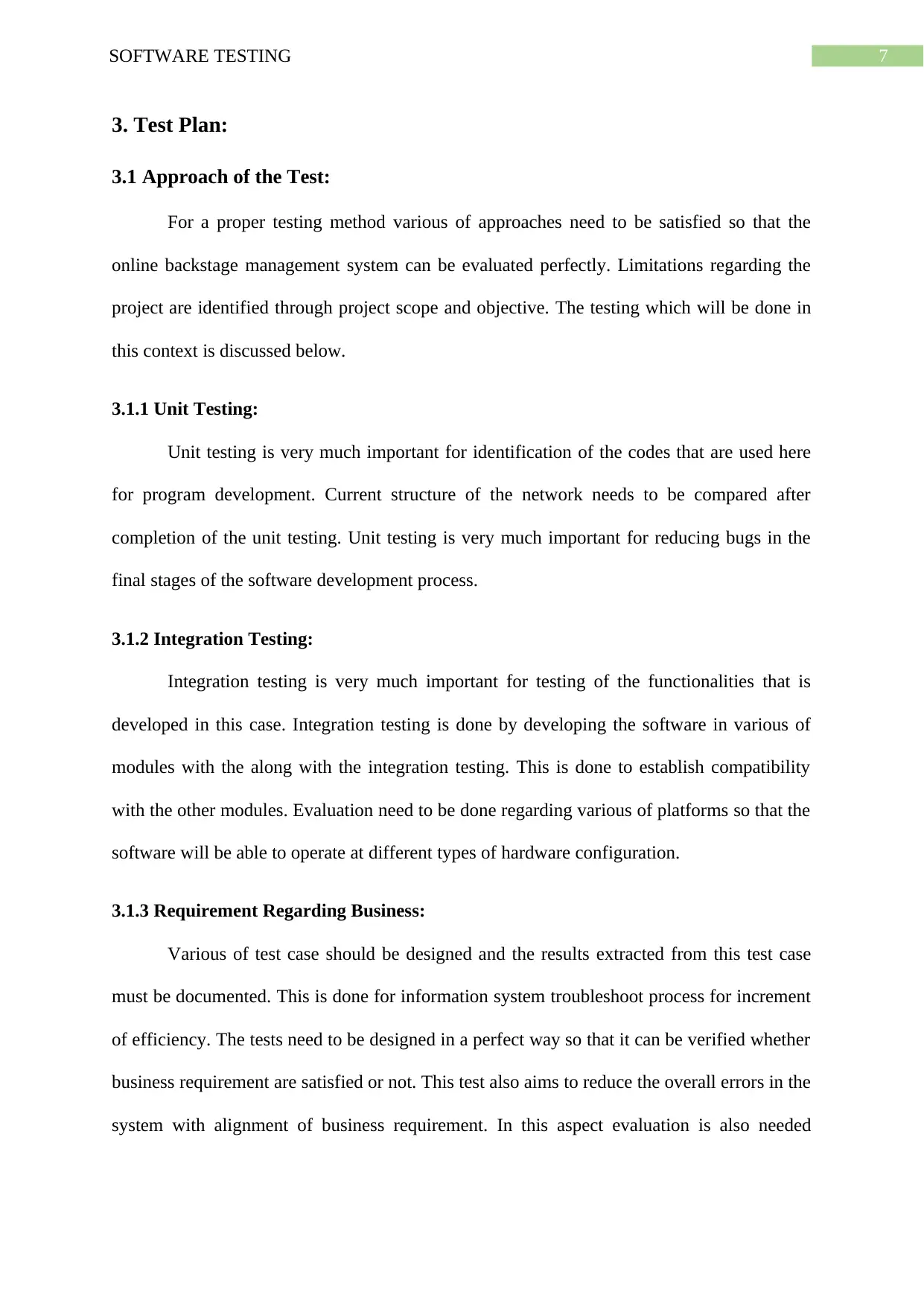
7SOFTWARE TESTING
3. Test Plan:
3.1 Approach of the Test:
For a proper testing method various of approaches need to be satisfied so that the
online backstage management system can be evaluated perfectly. Limitations regarding the
project are identified through project scope and objective. The testing which will be done in
this context is discussed below.
3.1.1 Unit Testing:
Unit testing is very much important for identification of the codes that are used here
for program development. Current structure of the network needs to be compared after
completion of the unit testing. Unit testing is very much important for reducing bugs in the
final stages of the software development process.
3.1.2 Integration Testing:
Integration testing is very much important for testing of the functionalities that is
developed in this case. Integration testing is done by developing the software in various of
modules with the along with the integration testing. This is done to establish compatibility
with the other modules. Evaluation need to be done regarding various of platforms so that the
software will be able to operate at different types of hardware configuration.
3.1.3 Requirement Regarding Business:
Various of test case should be designed and the results extracted from this test case
must be documented. This is done for information system troubleshoot process for increment
of efficiency. The tests need to be designed in a perfect way so that it can be verified whether
business requirement are satisfied or not. This test also aims to reduce the overall errors in the
system with alignment of business requirement. In this aspect evaluation is also needed
3. Test Plan:
3.1 Approach of the Test:
For a proper testing method various of approaches need to be satisfied so that the
online backstage management system can be evaluated perfectly. Limitations regarding the
project are identified through project scope and objective. The testing which will be done in
this context is discussed below.
3.1.1 Unit Testing:
Unit testing is very much important for identification of the codes that are used here
for program development. Current structure of the network needs to be compared after
completion of the unit testing. Unit testing is very much important for reducing bugs in the
final stages of the software development process.
3.1.2 Integration Testing:
Integration testing is very much important for testing of the functionalities that is
developed in this case. Integration testing is done by developing the software in various of
modules with the along with the integration testing. This is done to establish compatibility
with the other modules. Evaluation need to be done regarding various of platforms so that the
software will be able to operate at different types of hardware configuration.
3.1.3 Requirement Regarding Business:
Various of test case should be designed and the results extracted from this test case
must be documented. This is done for information system troubleshoot process for increment
of efficiency. The tests need to be designed in a perfect way so that it can be verified whether
business requirement are satisfied or not. This test also aims to reduce the overall errors in the
system with alignment of business requirement. In this aspect evaluation is also needed
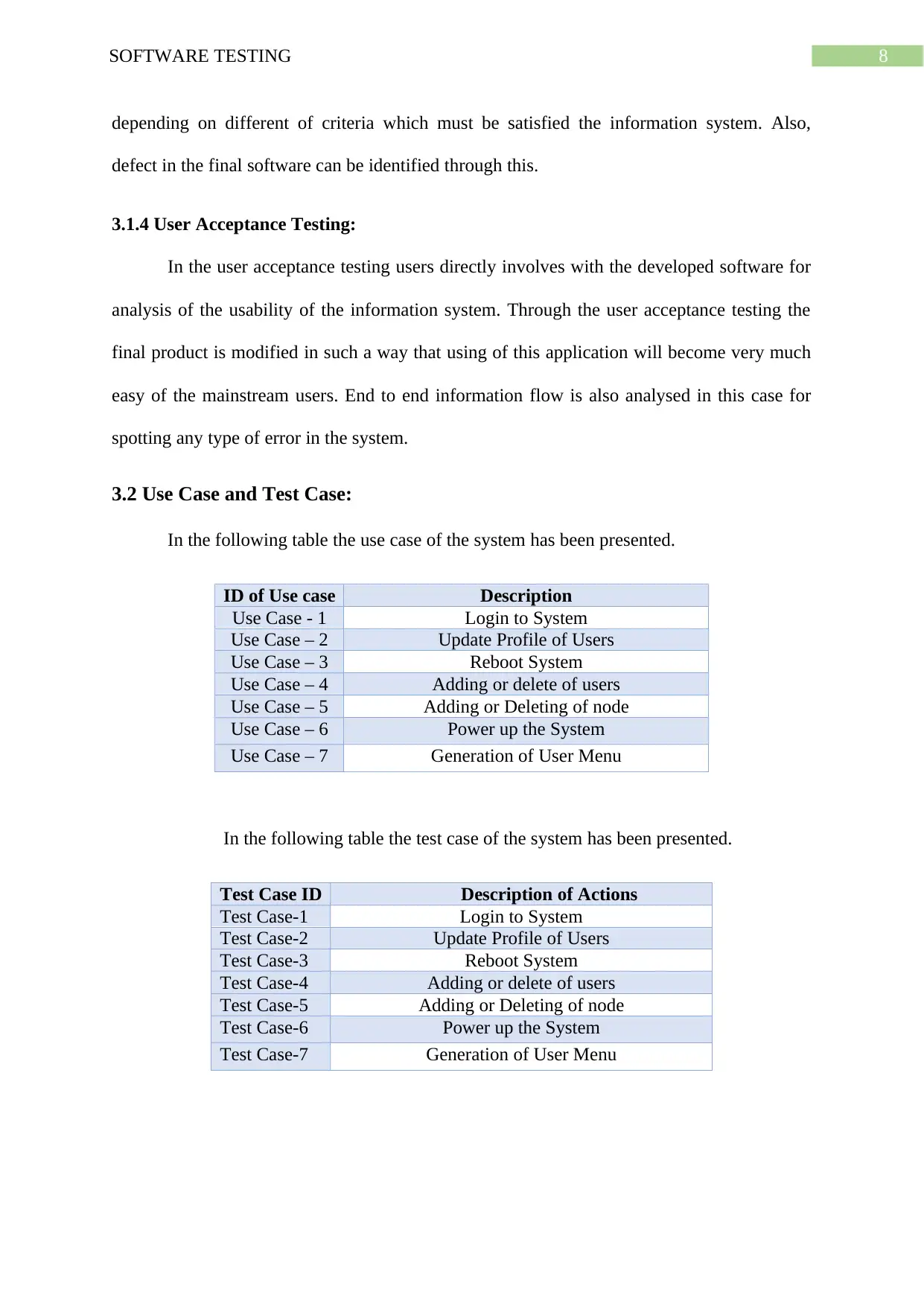
8SOFTWARE TESTING
depending on different of criteria which must be satisfied the information system. Also,
defect in the final software can be identified through this.
3.1.4 User Acceptance Testing:
In the user acceptance testing users directly involves with the developed software for
analysis of the usability of the information system. Through the user acceptance testing the
final product is modified in such a way that using of this application will become very much
easy of the mainstream users. End to end information flow is also analysed in this case for
spotting any type of error in the system.
3.2 Use Case and Test Case:
In the following table the use case of the system has been presented.
ID of Use case Description
Use Case - 1 Login to System
Use Case – 2 Update Profile of Users
Use Case – 3 Reboot System
Use Case – 4 Adding or delete of users
Use Case – 5 Adding or Deleting of node
Use Case – 6 Power up the System
Use Case – 7 Generation of User Menu
In the following table the test case of the system has been presented.
Test Case ID Description of Actions
Test Case-1 Login to System
Test Case-2 Update Profile of Users
Test Case-3 Reboot System
Test Case-4 Adding or delete of users
Test Case-5 Adding or Deleting of node
Test Case-6 Power up the System
Test Case-7 Generation of User Menu
depending on different of criteria which must be satisfied the information system. Also,
defect in the final software can be identified through this.
3.1.4 User Acceptance Testing:
In the user acceptance testing users directly involves with the developed software for
analysis of the usability of the information system. Through the user acceptance testing the
final product is modified in such a way that using of this application will become very much
easy of the mainstream users. End to end information flow is also analysed in this case for
spotting any type of error in the system.
3.2 Use Case and Test Case:
In the following table the use case of the system has been presented.
ID of Use case Description
Use Case - 1 Login to System
Use Case – 2 Update Profile of Users
Use Case – 3 Reboot System
Use Case – 4 Adding or delete of users
Use Case – 5 Adding or Deleting of node
Use Case – 6 Power up the System
Use Case – 7 Generation of User Menu
In the following table the test case of the system has been presented.
Test Case ID Description of Actions
Test Case-1 Login to System
Test Case-2 Update Profile of Users
Test Case-3 Reboot System
Test Case-4 Adding or delete of users
Test Case-5 Adding or Deleting of node
Test Case-6 Power up the System
Test Case-7 Generation of User Menu
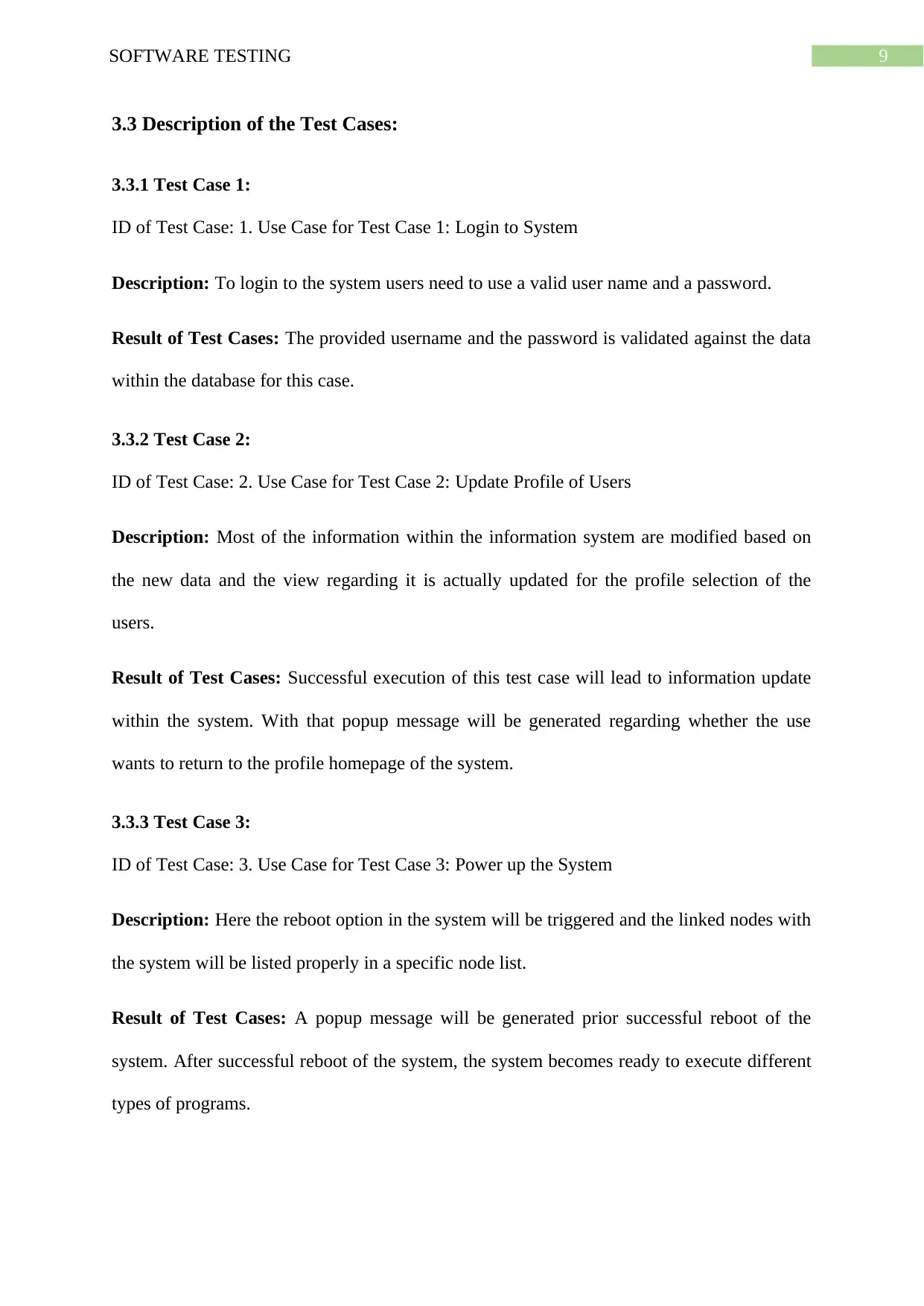
9SOFTWARE TESTING
3.3 Description of the Test Cases:
3.3.1 Test Case 1:
ID of Test Case: 1. Use Case for Test Case 1: Login to System
Description: To login to the system users need to use a valid user name and a password.
Result of Test Cases: The provided username and the password is validated against the data
within the database for this case.
3.3.2 Test Case 2:
ID of Test Case: 2. Use Case for Test Case 2: Update Profile of Users
Description: Most of the information within the information system are modified based on
the new data and the view regarding it is actually updated for the profile selection of the
users.
Result of Test Cases: Successful execution of this test case will lead to information update
within the system. With that popup message will be generated regarding whether the use
wants to return to the profile homepage of the system.
3.3.3 Test Case 3:
ID of Test Case: 3. Use Case for Test Case 3: Power up the System
Description: Here the reboot option in the system will be triggered and the linked nodes with
the system will be listed properly in a specific node list.
Result of Test Cases: A popup message will be generated prior successful reboot of the
system. After successful reboot of the system, the system becomes ready to execute different
types of programs.
3.3 Description of the Test Cases:
3.3.1 Test Case 1:
ID of Test Case: 1. Use Case for Test Case 1: Login to System
Description: To login to the system users need to use a valid user name and a password.
Result of Test Cases: The provided username and the password is validated against the data
within the database for this case.
3.3.2 Test Case 2:
ID of Test Case: 2. Use Case for Test Case 2: Update Profile of Users
Description: Most of the information within the information system are modified based on
the new data and the view regarding it is actually updated for the profile selection of the
users.
Result of Test Cases: Successful execution of this test case will lead to information update
within the system. With that popup message will be generated regarding whether the use
wants to return to the profile homepage of the system.
3.3.3 Test Case 3:
ID of Test Case: 3. Use Case for Test Case 3: Power up the System
Description: Here the reboot option in the system will be triggered and the linked nodes with
the system will be listed properly in a specific node list.
Result of Test Cases: A popup message will be generated prior successful reboot of the
system. After successful reboot of the system, the system becomes ready to execute different
types of programs.
Secure Best Marks with AI Grader
Need help grading? Try our AI Grader for instant feedback on your assignments.
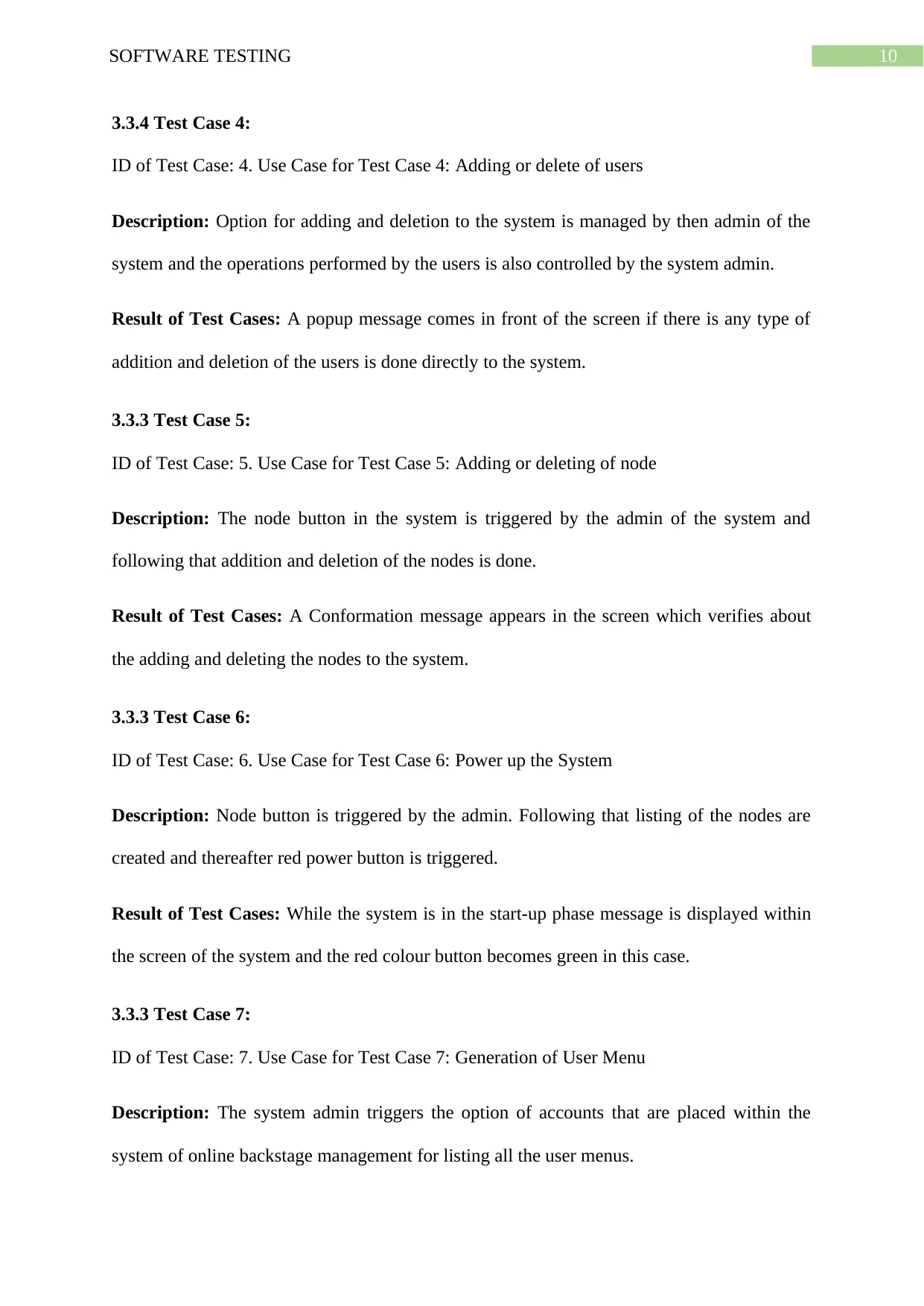
10SOFTWARE TESTING
3.3.4 Test Case 4:
ID of Test Case: 4. Use Case for Test Case 4: Adding or delete of users
Description: Option for adding and deletion to the system is managed by then admin of the
system and the operations performed by the users is also controlled by the system admin.
Result of Test Cases: A popup message comes in front of the screen if there is any type of
addition and deletion of the users is done directly to the system.
3.3.3 Test Case 5:
ID of Test Case: 5. Use Case for Test Case 5: Adding or deleting of node
Description: The node button in the system is triggered by the admin of the system and
following that addition and deletion of the nodes is done.
Result of Test Cases: A Conformation message appears in the screen which verifies about
the adding and deleting the nodes to the system.
3.3.3 Test Case 6:
ID of Test Case: 6. Use Case for Test Case 6: Power up the System
Description: Node button is triggered by the admin. Following that listing of the nodes are
created and thereafter red power button is triggered.
Result of Test Cases: While the system is in the start-up phase message is displayed within
the screen of the system and the red colour button becomes green in this case.
3.3.3 Test Case 7:
ID of Test Case: 7. Use Case for Test Case 7: Generation of User Menu
Description: The system admin triggers the option of accounts that are placed within the
system of online backstage management for listing all the user menus.
3.3.4 Test Case 4:
ID of Test Case: 4. Use Case for Test Case 4: Adding or delete of users
Description: Option for adding and deletion to the system is managed by then admin of the
system and the operations performed by the users is also controlled by the system admin.
Result of Test Cases: A popup message comes in front of the screen if there is any type of
addition and deletion of the users is done directly to the system.
3.3.3 Test Case 5:
ID of Test Case: 5. Use Case for Test Case 5: Adding or deleting of node
Description: The node button in the system is triggered by the admin of the system and
following that addition and deletion of the nodes is done.
Result of Test Cases: A Conformation message appears in the screen which verifies about
the adding and deleting the nodes to the system.
3.3.3 Test Case 6:
ID of Test Case: 6. Use Case for Test Case 6: Power up the System
Description: Node button is triggered by the admin. Following that listing of the nodes are
created and thereafter red power button is triggered.
Result of Test Cases: While the system is in the start-up phase message is displayed within
the screen of the system and the red colour button becomes green in this case.
3.3.3 Test Case 7:
ID of Test Case: 7. Use Case for Test Case 7: Generation of User Menu
Description: The system admin triggers the option of accounts that are placed within the
system of online backstage management for listing all the user menus.
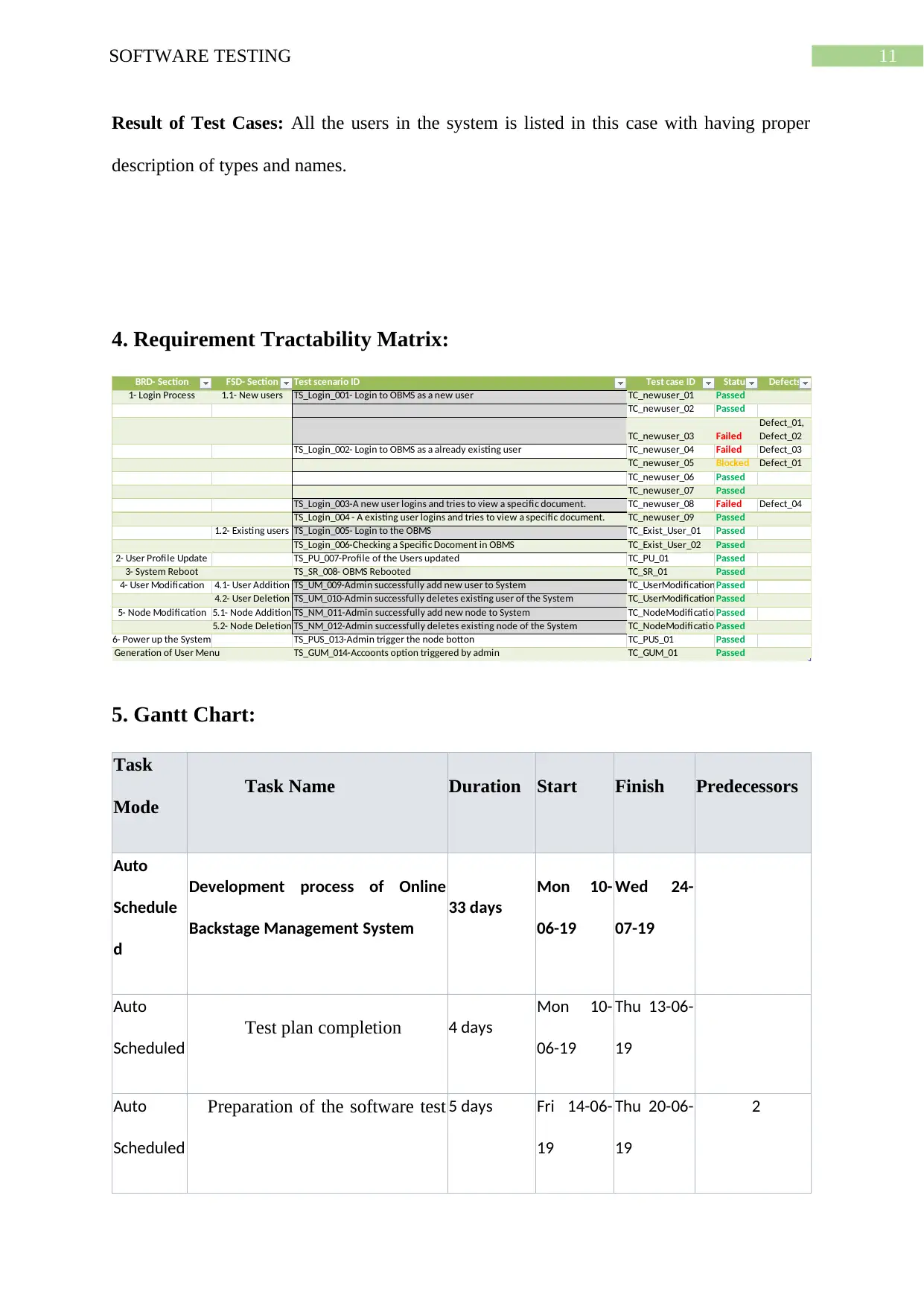
11SOFTWARE TESTING
Result of Test Cases: All the users in the system is listed in this case with having proper
description of types and names.
4. Requirement Tractability Matrix:
BRD- Section FSD- Section Test scenario ID Test case ID Status Defects
1- Login Process 1.1- New users TS_Login_001- Login to OBMS as a new user TC_newuser_01 Passed
TC_newuser_02 Passed
TC_newuser_03 Failed
Defect_01,
Defect_02
TS_Login_002- Login to OBMS as a already existing user TC_newuser_04 Failed Defect_03
TC_newuser_05 Blocked Defect_01
TC_newuser_06 Passed
TC_newuser_07 Passed
TS_Login_003-A new user logins and tries to view a specific document. TC_newuser_08 Failed Defect_04
TS_Login_004 - A existing user logins and tries to view a specific document. TC_newuser_09 Passed
1.2- Existing users TS_Login_005- Login to the OBMS TC_Exist_User_01 Passed
TS_Login_006-Checking a Specific Docoment in OBMS TC_Exist_User_02 Passed
2- User Profile Update TS_PU_007-Profile of the Users updated TC_PU_01 Passed
3- System Reboot TS_SR_008- OBMS Rebooted TC_SR_01 Passed
4- User Modification 4.1- User Addition TS_UM_009-Admin successfully add new user to System TC_UserModification_01Passed
4.2- User Deletion TS_UM_010-Admin successfully deletes existing user of the System TC_UserModification_02Passed
5- Node Modification 5.1- Node Addition TS_NM_011-Admin successfully add new node to System TC_NodeModification_01Passed
5.2- Node Deletion TS_NM_012-Admin successfully deletes existing node of the System TC_NodeModification_02Passed
6- Power up the System TS_PUS_013-Admin trigger the node botton TC_PUS_01 Passed
7- Generation of User Menu TS_GUM_014-Accoonts option triggered by admin TC_GUM_01 Passed
5. Gantt Chart:
Task
Mode
Task Name Duration Start Finish Predecessors
Auto
Schedule
d
Development process of Online
Backstage Management System
33 days
Mon 10-
06-19
Wed 24-
07-19
Auto
Scheduled
Test plan completion 4 days
Mon 10-
06-19
Thu 13-06-
19
Auto
Scheduled
Preparation of the software test 5 days Fri 14-06-
19
Thu 20-06-
19
2
Result of Test Cases: All the users in the system is listed in this case with having proper
description of types and names.
4. Requirement Tractability Matrix:
BRD- Section FSD- Section Test scenario ID Test case ID Status Defects
1- Login Process 1.1- New users TS_Login_001- Login to OBMS as a new user TC_newuser_01 Passed
TC_newuser_02 Passed
TC_newuser_03 Failed
Defect_01,
Defect_02
TS_Login_002- Login to OBMS as a already existing user TC_newuser_04 Failed Defect_03
TC_newuser_05 Blocked Defect_01
TC_newuser_06 Passed
TC_newuser_07 Passed
TS_Login_003-A new user logins and tries to view a specific document. TC_newuser_08 Failed Defect_04
TS_Login_004 - A existing user logins and tries to view a specific document. TC_newuser_09 Passed
1.2- Existing users TS_Login_005- Login to the OBMS TC_Exist_User_01 Passed
TS_Login_006-Checking a Specific Docoment in OBMS TC_Exist_User_02 Passed
2- User Profile Update TS_PU_007-Profile of the Users updated TC_PU_01 Passed
3- System Reboot TS_SR_008- OBMS Rebooted TC_SR_01 Passed
4- User Modification 4.1- User Addition TS_UM_009-Admin successfully add new user to System TC_UserModification_01Passed
4.2- User Deletion TS_UM_010-Admin successfully deletes existing user of the System TC_UserModification_02Passed
5- Node Modification 5.1- Node Addition TS_NM_011-Admin successfully add new node to System TC_NodeModification_01Passed
5.2- Node Deletion TS_NM_012-Admin successfully deletes existing node of the System TC_NodeModification_02Passed
6- Power up the System TS_PUS_013-Admin trigger the node botton TC_PUS_01 Passed
7- Generation of User Menu TS_GUM_014-Accoonts option triggered by admin TC_GUM_01 Passed
5. Gantt Chart:
Task
Mode
Task Name Duration Start Finish Predecessors
Auto
Schedule
d
Development process of Online
Backstage Management System
33 days
Mon 10-
06-19
Wed 24-
07-19
Auto
Scheduled
Test plan completion 4 days
Mon 10-
06-19
Thu 13-06-
19
Auto
Scheduled
Preparation of the software test 5 days Fri 14-06-
19
Thu 20-06-
19
2
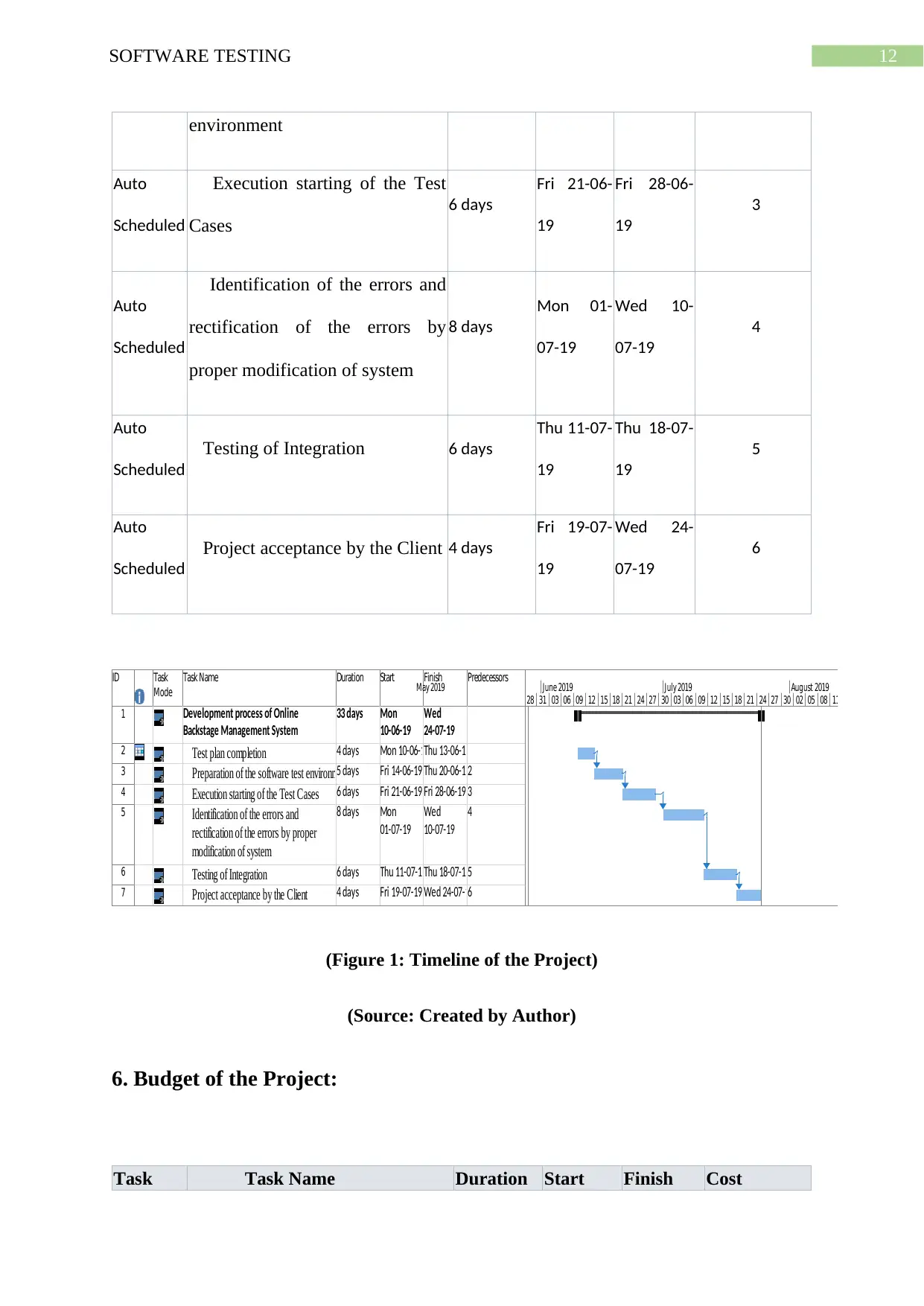
12SOFTWARE TESTING
environment
Auto
Scheduled
Execution starting of the Test
Cases
6 days
Fri 21-06-
19
Fri 28-06-
19
3
Auto
Scheduled
Identification of the errors and
rectification of the errors by
proper modification of system
8 days
Mon 01-
07-19
Wed 10-
07-19
4
Auto
Scheduled
Testing of Integration 6 days
Thu 11-07-
19
Thu 18-07-
19
5
Auto
Scheduled
Project acceptance by the Client 4 days
Fri 19-07-
19
Wed 24-
07-19
6
ID Task
Mode
Task Name Duration Start Finish Predecessors
1 Development process of Online
Backstage Management System
33 days Mon
10-06-19
Wed
24-07-19
2 Test plan completion 4 days Mon 10-06-19Thu 13-06-19
3 Preparation of the software test environment5 days Fri 14-06-19 Thu 20-06-192
4 Execution starting of the Test Cases 6 days Fri 21-06-19 Fri 28-06-19 3
5 Identification of the errors and
rectification of the errors by proper
modification of system
8 days Mon
01-07-19
Wed
10-07-19
4
6 Testing of Integration 6 days Thu 11-07-19Thu 18-07-195
7 Project acceptance by the Client 4 days Fri 19-07-19 Wed 24-07-196
28 31 03 06 09 12 15 18 21 24 27 30 03 06 09 12 15 18 21 24 27 30 02 05 08 11
May 2019 June 2019 July 2019 August 2019
(Figure 1: Timeline of the Project)
(Source: Created by Author)
6. Budget of the Project:
Task Task Name Duration Start Finish Cost
environment
Auto
Scheduled
Execution starting of the Test
Cases
6 days
Fri 21-06-
19
Fri 28-06-
19
3
Auto
Scheduled
Identification of the errors and
rectification of the errors by
proper modification of system
8 days
Mon 01-
07-19
Wed 10-
07-19
4
Auto
Scheduled
Testing of Integration 6 days
Thu 11-07-
19
Thu 18-07-
19
5
Auto
Scheduled
Project acceptance by the Client 4 days
Fri 19-07-
19
Wed 24-
07-19
6
ID Task
Mode
Task Name Duration Start Finish Predecessors
1 Development process of Online
Backstage Management System
33 days Mon
10-06-19
Wed
24-07-19
2 Test plan completion 4 days Mon 10-06-19Thu 13-06-19
3 Preparation of the software test environment5 days Fri 14-06-19 Thu 20-06-192
4 Execution starting of the Test Cases 6 days Fri 21-06-19 Fri 28-06-19 3
5 Identification of the errors and
rectification of the errors by proper
modification of system
8 days Mon
01-07-19
Wed
10-07-19
4
6 Testing of Integration 6 days Thu 11-07-19Thu 18-07-195
7 Project acceptance by the Client 4 days Fri 19-07-19 Wed 24-07-196
28 31 03 06 09 12 15 18 21 24 27 30 03 06 09 12 15 18 21 24 27 30 02 05 08 11
May 2019 June 2019 July 2019 August 2019
(Figure 1: Timeline of the Project)
(Source: Created by Author)
6. Budget of the Project:
Task Task Name Duration Start Finish Cost
Paraphrase This Document
Need a fresh take? Get an instant paraphrase of this document with our AI Paraphraser
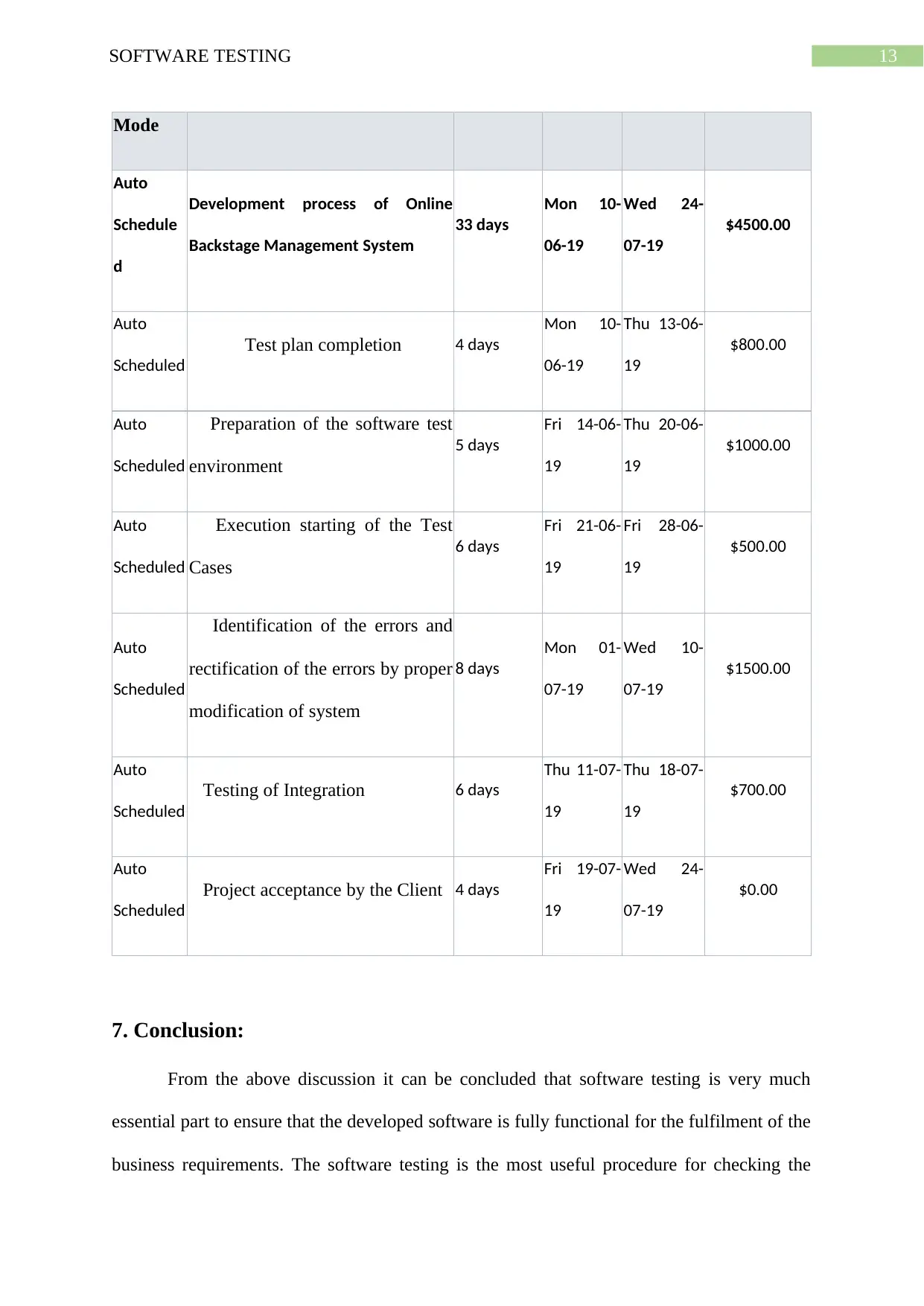
13SOFTWARE TESTING
Mode
Auto
Schedule
d
Development process of Online
Backstage Management System
33 days
Mon 10-
06-19
Wed 24-
07-19
$4500.00
Auto
Scheduled
Test plan completion 4 days
Mon 10-
06-19
Thu 13-06-
19
$800.00
Auto
Scheduled
Preparation of the software test
environment
5 days
Fri 14-06-
19
Thu 20-06-
19
$1000.00
Auto
Scheduled
Execution starting of the Test
Cases
6 days
Fri 21-06-
19
Fri 28-06-
19
$500.00
Auto
Scheduled
Identification of the errors and
rectification of the errors by proper
modification of system
8 days
Mon 01-
07-19
Wed 10-
07-19
$1500.00
Auto
Scheduled
Testing of Integration 6 days
Thu 11-07-
19
Thu 18-07-
19
$700.00
Auto
Scheduled
Project acceptance by the Client 4 days
Fri 19-07-
19
Wed 24-
07-19
$0.00
7. Conclusion:
From the above discussion it can be concluded that software testing is very much
essential part to ensure that the developed software is fully functional for the fulfilment of the
business requirements. The software testing is the most useful procedure for checking the
Mode
Auto
Schedule
d
Development process of Online
Backstage Management System
33 days
Mon 10-
06-19
Wed 24-
07-19
$4500.00
Auto
Scheduled
Test plan completion 4 days
Mon 10-
06-19
Thu 13-06-
19
$800.00
Auto
Scheduled
Preparation of the software test
environment
5 days
Fri 14-06-
19
Thu 20-06-
19
$1000.00
Auto
Scheduled
Execution starting of the Test
Cases
6 days
Fri 21-06-
19
Fri 28-06-
19
$500.00
Auto
Scheduled
Identification of the errors and
rectification of the errors by proper
modification of system
8 days
Mon 01-
07-19
Wed 10-
07-19
$1500.00
Auto
Scheduled
Testing of Integration 6 days
Thu 11-07-
19
Thu 18-07-
19
$700.00
Auto
Scheduled
Project acceptance by the Client 4 days
Fri 19-07-
19
Wed 24-
07-19
$0.00
7. Conclusion:
From the above discussion it can be concluded that software testing is very much
essential part to ensure that the developed software is fully functional for the fulfilment of the
business requirements. The software testing is the most useful procedure for checking the

14SOFTWARE TESTING
functionality of the software. In this report, software testing has been done for online
backstage management system. In this report for successful completion of the software
testing project for the online backstage management system different types of criterion and
steps has been followed for the execution of the test plan. This steps include test design
description and this has been divided further into two steps which are the test procedure
description and the test case description. Log test has been shown in this report for the test
execution. A summary test report has been also generated in this context. Through this report
accomplishing all the requirements which are mentioned within the testing plan and test
procedure has been implemented in this case which is manageable, measurable and
repeatable in nature. Several types of functionality of the online backstage management
system has been described through the test plan of this document and the whole software has
been evaluated perfectly. If any type of errors found in the system then these issues has been
identified and addressed using the current test plans for the developing an error free quality
software product for the mainstream customers.
functionality of the software. In this report, software testing has been done for online
backstage management system. In this report for successful completion of the software
testing project for the online backstage management system different types of criterion and
steps has been followed for the execution of the test plan. This steps include test design
description and this has been divided further into two steps which are the test procedure
description and the test case description. Log test has been shown in this report for the test
execution. A summary test report has been also generated in this context. Through this report
accomplishing all the requirements which are mentioned within the testing plan and test
procedure has been implemented in this case which is manageable, measurable and
repeatable in nature. Several types of functionality of the online backstage management
system has been described through the test plan of this document and the whole software has
been evaluated perfectly. If any type of errors found in the system then these issues has been
identified and addressed using the current test plans for the developing an error free quality
software product for the mainstream customers.
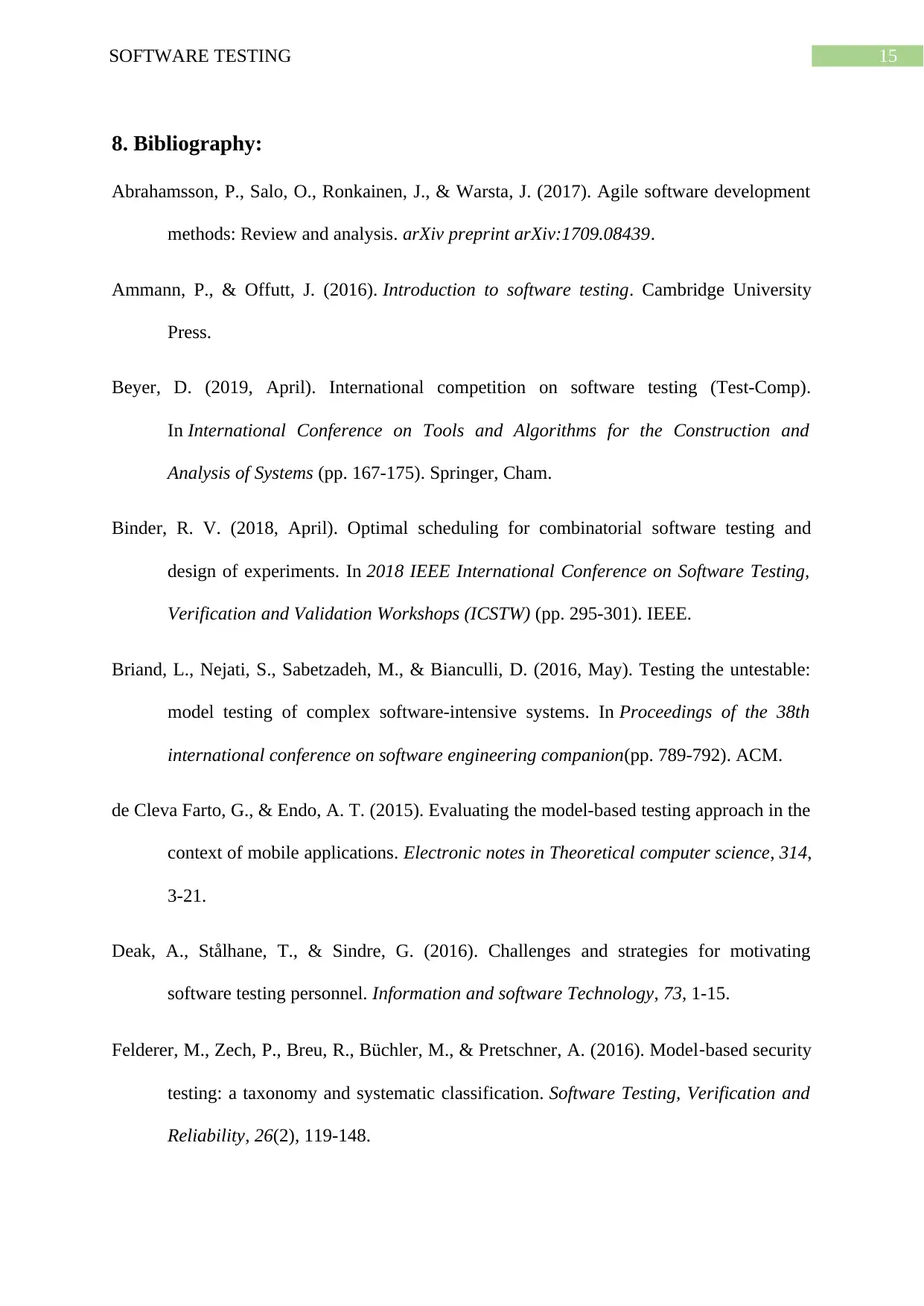
15SOFTWARE TESTING
8. Bibliography:
Abrahamsson, P., Salo, O., Ronkainen, J., & Warsta, J. (2017). Agile software development
methods: Review and analysis. arXiv preprint arXiv:1709.08439.
Ammann, P., & Offutt, J. (2016). Introduction to software testing. Cambridge University
Press.
Beyer, D. (2019, April). International competition on software testing (Test-Comp).
In International Conference on Tools and Algorithms for the Construction and
Analysis of Systems (pp. 167-175). Springer, Cham.
Binder, R. V. (2018, April). Optimal scheduling for combinatorial software testing and
design of experiments. In 2018 IEEE International Conference on Software Testing,
Verification and Validation Workshops (ICSTW) (pp. 295-301). IEEE.
Briand, L., Nejati, S., Sabetzadeh, M., & Bianculli, D. (2016, May). Testing the untestable:
model testing of complex software-intensive systems. In Proceedings of the 38th
international conference on software engineering companion(pp. 789-792). ACM.
de Cleva Farto, G., & Endo, A. T. (2015). Evaluating the model-based testing approach in the
context of mobile applications. Electronic notes in Theoretical computer science, 314,
3-21.
Deak, A., Stålhane, T., & Sindre, G. (2016). Challenges and strategies for motivating
software testing personnel. Information and software Technology, 73, 1-15.
Felderer, M., Zech, P., Breu, R., Büchler, M., & Pretschner, A. (2016). Model‐based security
testing: a taxonomy and systematic classification. Software Testing, Verification and
Reliability, 26(2), 119-148.
8. Bibliography:
Abrahamsson, P., Salo, O., Ronkainen, J., & Warsta, J. (2017). Agile software development
methods: Review and analysis. arXiv preprint arXiv:1709.08439.
Ammann, P., & Offutt, J. (2016). Introduction to software testing. Cambridge University
Press.
Beyer, D. (2019, April). International competition on software testing (Test-Comp).
In International Conference on Tools and Algorithms for the Construction and
Analysis of Systems (pp. 167-175). Springer, Cham.
Binder, R. V. (2018, April). Optimal scheduling for combinatorial software testing and
design of experiments. In 2018 IEEE International Conference on Software Testing,
Verification and Validation Workshops (ICSTW) (pp. 295-301). IEEE.
Briand, L., Nejati, S., Sabetzadeh, M., & Bianculli, D. (2016, May). Testing the untestable:
model testing of complex software-intensive systems. In Proceedings of the 38th
international conference on software engineering companion(pp. 789-792). ACM.
de Cleva Farto, G., & Endo, A. T. (2015). Evaluating the model-based testing approach in the
context of mobile applications. Electronic notes in Theoretical computer science, 314,
3-21.
Deak, A., Stålhane, T., & Sindre, G. (2016). Challenges and strategies for motivating
software testing personnel. Information and software Technology, 73, 1-15.
Felderer, M., Zech, P., Breu, R., Büchler, M., & Pretschner, A. (2016). Model‐based security
testing: a taxonomy and systematic classification. Software Testing, Verification and
Reliability, 26(2), 119-148.
Secure Best Marks with AI Grader
Need help grading? Try our AI Grader for instant feedback on your assignments.
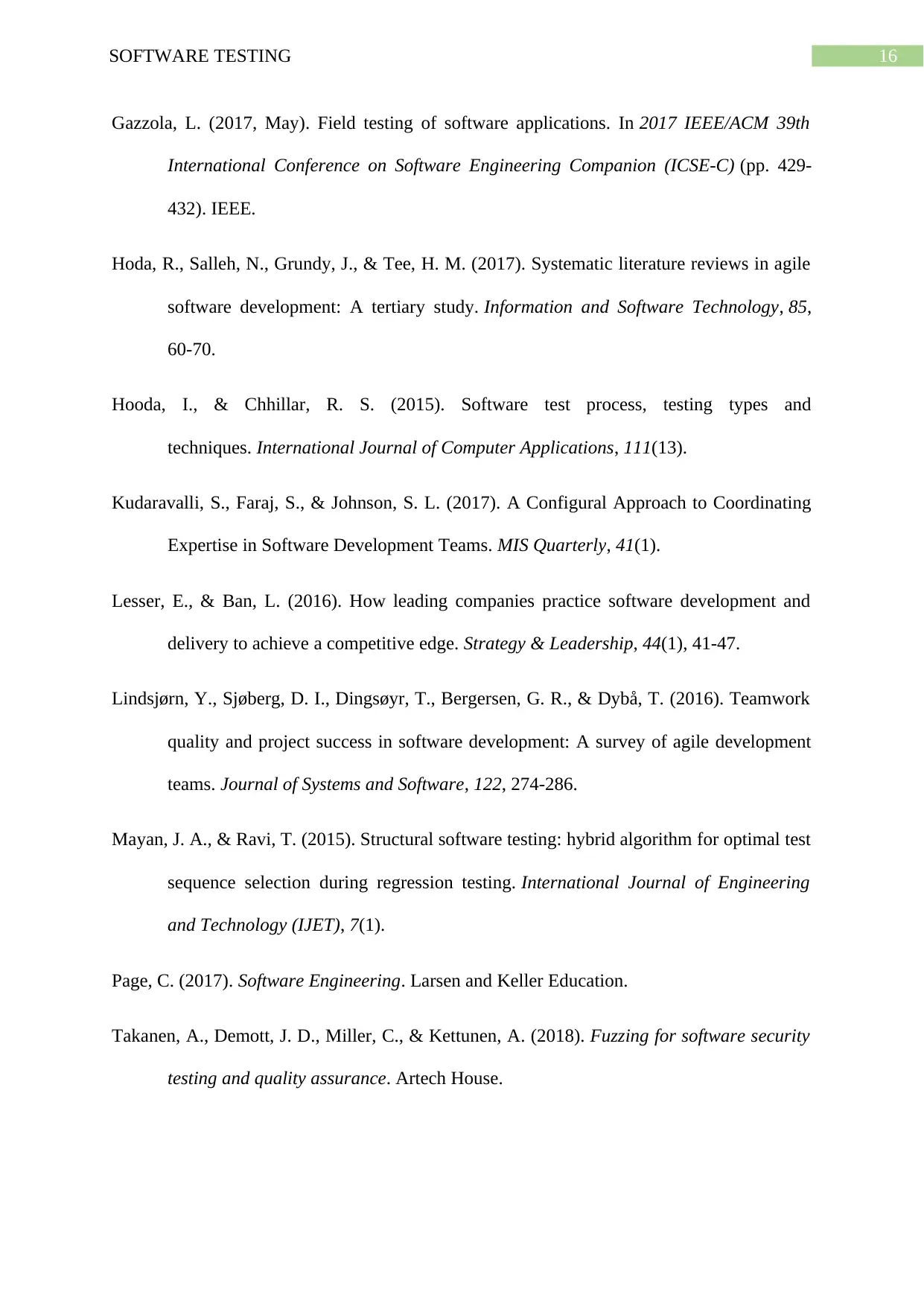
16SOFTWARE TESTING
Gazzola, L. (2017, May). Field testing of software applications. In 2017 IEEE/ACM 39th
International Conference on Software Engineering Companion (ICSE-C) (pp. 429-
432). IEEE.
Hoda, R., Salleh, N., Grundy, J., & Tee, H. M. (2017). Systematic literature reviews in agile
software development: A tertiary study. Information and Software Technology, 85,
60-70.
Hooda, I., & Chhillar, R. S. (2015). Software test process, testing types and
techniques. International Journal of Computer Applications, 111(13).
Kudaravalli, S., Faraj, S., & Johnson, S. L. (2017). A Configural Approach to Coordinating
Expertise in Software Development Teams. MIS Quarterly, 41(1).
Lesser, E., & Ban, L. (2016). How leading companies practice software development and
delivery to achieve a competitive edge. Strategy & Leadership, 44(1), 41-47.
Lindsjørn, Y., Sjøberg, D. I., Dingsøyr, T., Bergersen, G. R., & Dybå, T. (2016). Teamwork
quality and project success in software development: A survey of agile development
teams. Journal of Systems and Software, 122, 274-286.
Mayan, J. A., & Ravi, T. (2015). Structural software testing: hybrid algorithm for optimal test
sequence selection during regression testing. International Journal of Engineering
and Technology (IJET), 7(1).
Page, C. (2017). Software Engineering. Larsen and Keller Education.
Takanen, A., Demott, J. D., Miller, C., & Kettunen, A. (2018). Fuzzing for software security
testing and quality assurance. Artech House.
Gazzola, L. (2017, May). Field testing of software applications. In 2017 IEEE/ACM 39th
International Conference on Software Engineering Companion (ICSE-C) (pp. 429-
432). IEEE.
Hoda, R., Salleh, N., Grundy, J., & Tee, H. M. (2017). Systematic literature reviews in agile
software development: A tertiary study. Information and Software Technology, 85,
60-70.
Hooda, I., & Chhillar, R. S. (2015). Software test process, testing types and
techniques. International Journal of Computer Applications, 111(13).
Kudaravalli, S., Faraj, S., & Johnson, S. L. (2017). A Configural Approach to Coordinating
Expertise in Software Development Teams. MIS Quarterly, 41(1).
Lesser, E., & Ban, L. (2016). How leading companies practice software development and
delivery to achieve a competitive edge. Strategy & Leadership, 44(1), 41-47.
Lindsjørn, Y., Sjøberg, D. I., Dingsøyr, T., Bergersen, G. R., & Dybå, T. (2016). Teamwork
quality and project success in software development: A survey of agile development
teams. Journal of Systems and Software, 122, 274-286.
Mayan, J. A., & Ravi, T. (2015). Structural software testing: hybrid algorithm for optimal test
sequence selection during regression testing. International Journal of Engineering
and Technology (IJET), 7(1).
Page, C. (2017). Software Engineering. Larsen and Keller Education.
Takanen, A., Demott, J. D., Miller, C., & Kettunen, A. (2018). Fuzzing for software security
testing and quality assurance. Artech House.
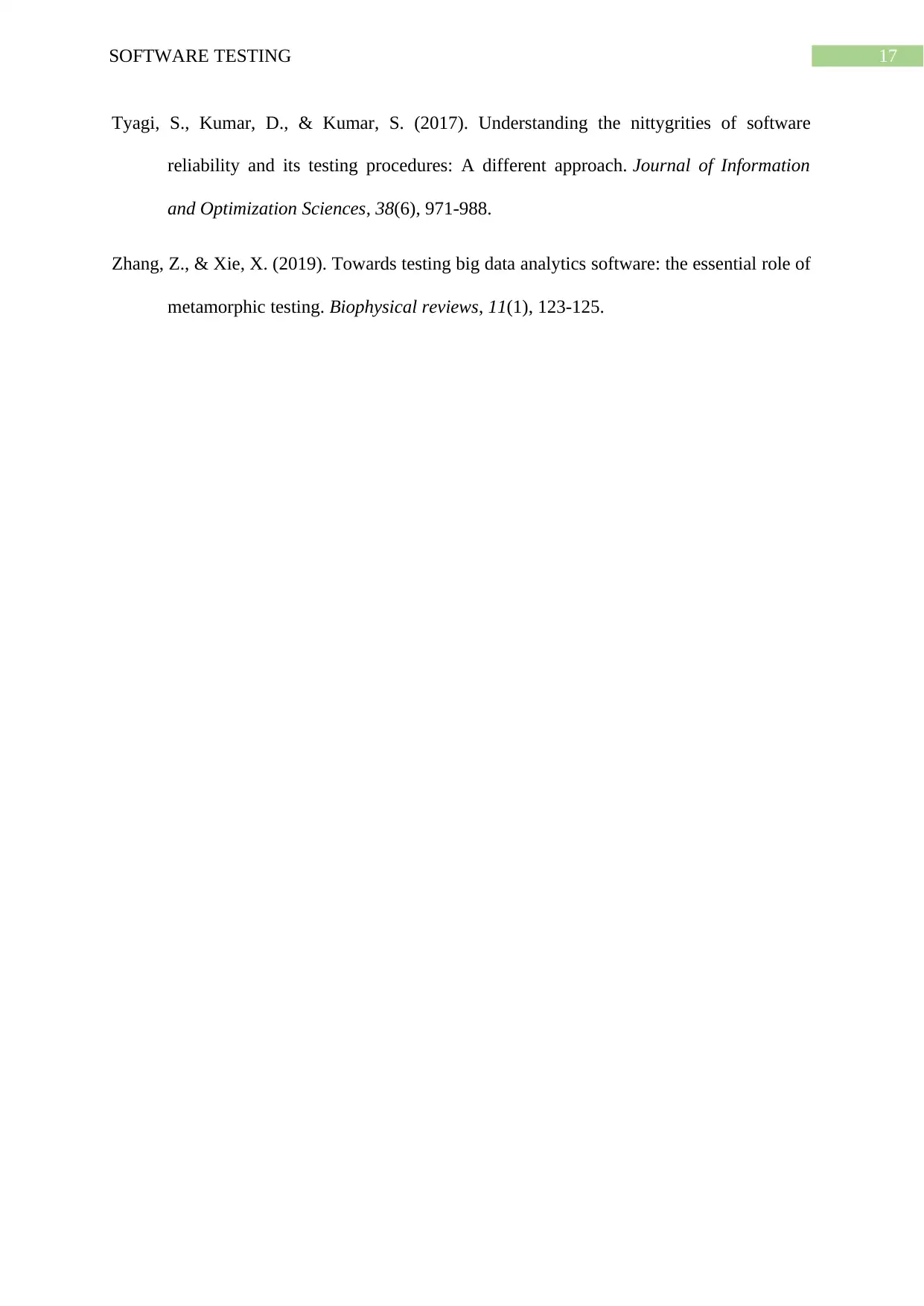
17SOFTWARE TESTING
Tyagi, S., Kumar, D., & Kumar, S. (2017). Understanding the nittygrities of software
reliability and its testing procedures: A different approach. Journal of Information
and Optimization Sciences, 38(6), 971-988.
Zhang, Z., & Xie, X. (2019). Towards testing big data analytics software: the essential role of
metamorphic testing. Biophysical reviews, 11(1), 123-125.
Tyagi, S., Kumar, D., & Kumar, S. (2017). Understanding the nittygrities of software
reliability and its testing procedures: A different approach. Journal of Information
and Optimization Sciences, 38(6), 971-988.
Zhang, Z., & Xie, X. (2019). Towards testing big data analytics software: the essential role of
metamorphic testing. Biophysical reviews, 11(1), 123-125.
1 out of 18
Related Documents
Your All-in-One AI-Powered Toolkit for Academic Success.
+13062052269
info@desklib.com
Available 24*7 on WhatsApp / Email
![[object Object]](/_next/static/media/star-bottom.7253800d.svg)
Unlock your academic potential
© 2024 | Zucol Services PVT LTD | All rights reserved.





